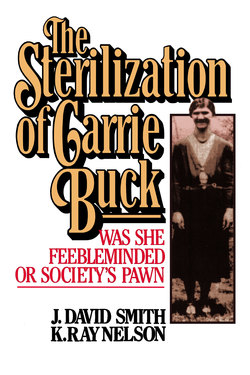Читать книгу Sterilization of Carrie Buck - David Smith - Страница 7
На сайте Литреса книга снята с продажи.
ОглавлениеAcknowledgment
The occasion of completing this book is a personal celebration for us. We have looked forward with great anticipation to sharing the story of Carrie Buck with interested readers. We relish seeing the manuscript that we have written, rewritten, and generally lived with for such a long time become a book. Our joy is magnified by having the opportunity here, on its beginning pages, to give words of thanks to those people who have been most supportive of our efforts to relate the facts and significance of the sexual sterilization of a young Virginia woman in 1927.
We were given invaluable assistance in our research for this book by several organizations and individuals:
Dr. Smith especially wishes to thank:
Commissioner Howard Cullum of the Virginia Department of Mental Health and Mental Retardation, who granted me access to Carrie Buck’s records at the Central Virginia Training Center. These records allowed me to understand and relate an important chapter of Carrie’s life. I am in Commissioner Cullum’s debt for recognizing the special circumstances of Carrie’s case and the importance of her story’s being told.
I am also enormously grateful to Senator Elliot Schewel of the Senate of Virginia for believing in the value of my work and who was an unfailing advocate in my quest to discover the details of Carrie’s story.
Dr. Bill Walker, Director of the Central Virginia Training Center, greatly facilitated my work there and I appreciate the encouragement he gave me. Two of his staff members, Ms. Helen Hardy, Director of Medical Records, and Ms. Helen Hester, Professional Library Director, were also most gracious and helpful.
I was received with hospitality in the Manuscripts Division of Alderman Library at the University of Virginia. I am particularly appreciative of Michael Plunkett’s help while I was reviewing the Aubrey Strode Collection there.
Martin Levitt was helpful and genuinely interested in my research during my several days at the American Philosophical Society.
The contact I had with people who had personal relationships with Carrie during her lifetime, or who knew her through family ties, brought a special quality to my understanding of her. I was given particularly valuable insights by Mr. and Mrs. A. T. Newberry, Mrs. Lucille Lewis, and Sharon Kincaid. By a delightful coincidence, my father-in-law, Fred Shaver, was able to send me to Jerry Layman, director of the nursing care facility where Carrie was a resident at the time of her death. Thanks to both.
From the start of my work on this book, I had the encouragement of my friend and colleague, Ed Polloway. He has been consistently tolerant of my obsessions and compulsions, and has often reassured me of the value of the work I have chosen to pursue. Rosel Schewel and Pete Warren have also been unfailing friends and have been mentors to me. I am lucky to have found them.
I was given assistance and support in this effort by the staff of the Lynchburg College Library. Such good people! The Committee on Faculty Research and Development at Lynchburg College provided some financial help for my research, and I am grateful. A major source of support was the Virginia Foundation for the Humanities. My freedom as a Fellow under the auspices of the Foundation allowed me to accomplish much of the research on the life of Aubrey Strode and my investigation of Carrie’s family history.
My work on Carrie Buck’s life was facilitated by those scholars who had previously investigated Buck v. Bell and related matters. I owe a great deal to the quality and care of their efforts. Primary regards in this respect are due Paul A. Lombardo.
Several people read early drafts of this book. Thanks go to Bob Lassiter, Ken West, Stephen Jay Gould, Mary Bishop and Tom Looney for helpful criticism and encouragement. I also appreciate the advice and interest of Hal Devening in the early stages of this work.
Phyllis Lane prepared the manuscript with care and good judgment. Through her fine work many of the mistakes in execution and expression were corrected. She is a trusted and respected colleague.
In addition to the above, Dr. Nelson gives special appreciation to:
Mrs. Juanita Cash, my secretary while I was Director of the Central Virginia Training Center, who received the inquiry that led to the location of Doris Buck, and eventually to Carrie Buck.
Mr. George Stoddard, a writer who went with me to visit Doris Buck Figgins, and whose newspaper article about that visit resulted in national attention being refocused on Carrie and Doris and the history of involuntary sterilization in America.
Finally, we are gratified with the confidence and trust invested in us and our telling of Carrie Buck’s story by our publisher, Joan Dunphy and editor, Richard Gingrich. Without Joan’s belief and support, The Sterilization of Carrie Buck might not be reaching its current audience. She has shown a concern for the importance of this book which is reflected in the quality of its presentation.
